Throughout the history of videogames, various consoles have served as one of the many pulpits for the gospel of film marketing. Videogame adaptations of movies are a strange breed. Motion Pixels will examine one such game each week, dissecting the basic gameplay, the graphics, and how faithfully it adapts the film on which it is based. Some are good, some are awful, and some are just downright weird, but they are all interesting experiments. We will also take a look at other cogs in a given film’s marketing machine. Grab some popcorn and a joystick and let the games begin!
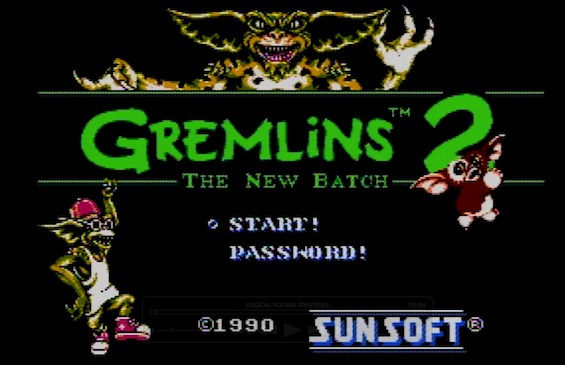
Game/Movie: Gremlins 2
System: Nintendo Entertainment System
Developer: Sunsoft
Year of Release: 1990
Graphics and Mechanics
Gremlins 2 utilizes an exceedingly simple game design. In fact, it is so simple, there’s no imperative to take up the entirety of the screen. It is a top-down adventure platformer with very narrow fields of play. As you play, the screen closely resembles that of Algernon’s maze, with sharp turns bordered by vast expanses of empty black. The game tenders very little confidence to the player as the angles of view remove any mystery in navigation and present but one path to follow. The most difficult thing about maneuvering through the levels is sometimes discerning the next safe landing spot once you’ve boarded a moving platform. Even then, it’s pretty self-evident.
The one inordinately exasperating aspect of the controls lies within Gizmo’s dexterity with his weapons. There is a function that allows him to not only fire in a forward/backward and side-to-side capacity, but also at diagonals.
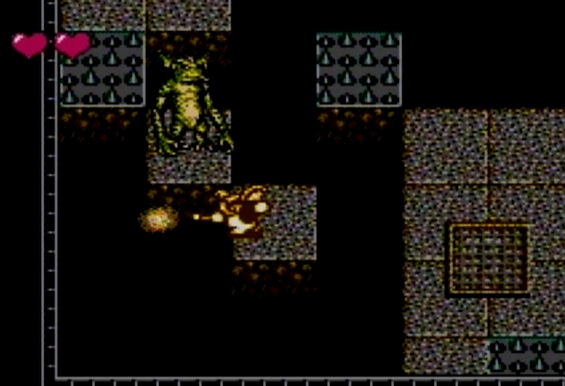
This function actually proves invaluable for taking out certain baddies. The problem is that the NES’s cross-shaped directional pad isn’t really adept at executing this trick…especially if a certain gamer’s fingers aren’t as *AHEM* slender as they used to be. Making large circles becomes a requirement as vainly you attempt over and over to enter the clandestine NXNW quadrant of the directional pad and eventually you luck into this coveted angle. But so many of the incidents that call for the angled attack are centralized on tiny shards of platforms over foreboding chasms. Suffice it to say, Gizmo’s range of motion is painfully limited and therefore any attempt to circle around results in an unfortunate plunge.
As for graphics, the environments are adequate given the 8-bit limitations. The pervasiveness of techno game elements (electric barriers, rotating dynamos, and circuit board decorum) gives many of the levels the appearance of leftover Mega Man aesthetic. But why are so many of the recognizable gremlins in the level woefully monochromatic? It makes them difficult to recognize and is especially unfortunate given that other, non film-specific villains are more richly designed. However, the 8-bit recreation of the scene in which Gizmo spawns the first mogwai brood...

...and gets locked in the air vent is fantastic and lovingly detailed.
Playing Before Instructions
The simplicity of Gremlins 2 in many ways precluded the need for any instructions. Again, owing much to a two-button controller setup, the basic gameplay is quite intuitive and very novice-friendly. Typically, it is unwise to recklessly blunder your way full-tilt through a level when playing any game for the first time. But Gremlins 2 accommodates the more bull-headed gamer by providing an endless supply of continues. As if that weren’t enough, it also employs the familiar password system so that even switching off the system need not send one reeling back to the first level.
Then there is the incredibly bizarre balloon extraction element. During each attempt at each new level, the first time Gizmo falls into any of the numerous pits, he returns to the screen tethered to a shiny balloon the trajectory of which can then be controlled by the player until it disappears.
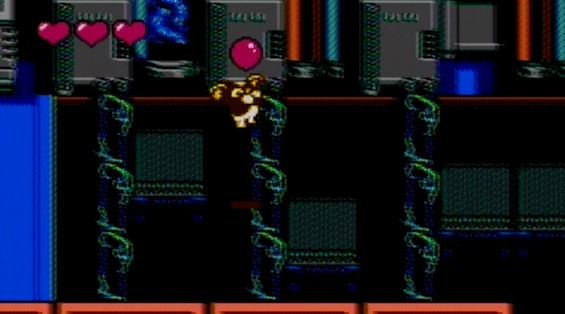
If you manage to fall before losing any of your health, this whimsically absurd flight will cost you no such loss. It’s similar to the “save ball” function in a pinball machine. If manipulated correctly, one could simply intentionally fall into a hole in order to sail over the more difficult portions of the level that follow. This may make the game seem shamefully unchallenging, but it actually nicely counterbalances the fact that each level provides only one opportunity to replenish one’s health.
Mission Accomplished?
This is becoming my least favorite section to address. I am ashamed to admit that I was unable to triumph over Gremlins 2. I made it all the way to the final boss, an impressively animated 8-bit likeness of the sinister spider gremlin...
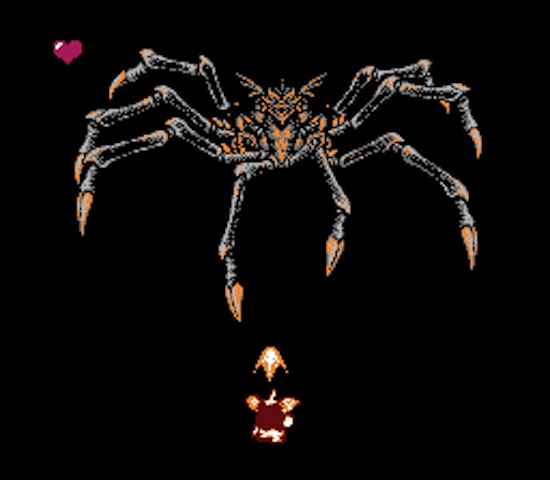
...but never with enough health in reserve to facilitate my victory. The final level—which serves as the gateway to the boss of bosses—is so taxing, so aggravatingly difficult that on the handful of occasions in which I was able to successfully traverse it, my health was so depleted that I was unable to put up much of a fight. It was obvious that the key to defeating the final boss lay in finding safe haven between two of his legs as he commenced his forward attack. But reaching him with only the capacity to withstand a single hit was insufficient to take full advantage. Damn this game for combining two of my greatest fears: spiders and failing to destroy spiders.
As much as I appreciate, and was in some small way aided by, the myriad continues offered by the game, it struck me as odd that the levels themselves were often far more difficult than the bosses lying in wait at the end. Apart from Arachnid McSpiderpants at the finale, the key to defeating each level’s boss was discovering the limitations of their movement and slowly exploiting it, be it traveling in large circles or shooting through objects you understand your nemesis cannot. So why is it that dying at the hands of the boss would result in having to play the entire preceding level over again? Maybe it’s a personal inclination, but I always prefer games that subscribe to the die-at-the-boss-respawn-at-the-boss model, especially after levels that are seventeen kinds of difficult. Otherwise it’s like completing a cross-country road trip, stepping on a jagged seashell at the beach, and having to start the trip again from your driveway.
Faithful to its Source?
Many of the film’s signature creatures make an appearance: the brain gremlin, the bat gremlin, the spider gremlin, the especially dopey gremlin who turns up in the noodle pot during the cooking show, and that electro gremlin who proves to be far more crucial to the film than he does to the game. The game also takes place entirely within the Clamp Premier Regency Trade Center and Retail Concourse, which is another faithful film-to-game carryover. The fact that almost the entire movie takes place in one location with various floors (or levels if you will) lends itself quite nicely to game adaptation. They even go so far as to evolve a throwaway joke in the film about bouncing tomatoes into one of the first villains the player encounters in the game. Throw in Dante’s manic obsession with (read full-on genuflection to) Looney Tunes and you’ve got the film’s mirror image.
I also enjoyed the fact that the game includes an ongoing reference to one of Gremlins 2’s most memorable scenes. Upon completion of the first level, Gizmo obtains a match. His weapon then graduates from tomatoes, another reference to that terrible joke, to balls of fire. Defeating the first of the game’s bosses then secures him a paper clip, which in turn leads to another graduation of weaponry to the almighty…paper clip? In any event, what is happening is that Gizmo is slowly building his makeshift Rambo bow-and-arrow from the film.
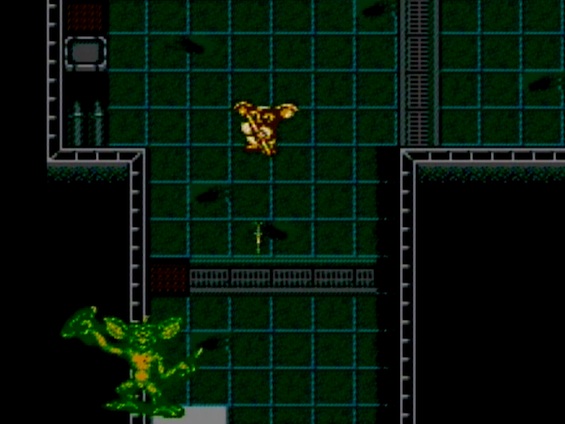
When all the requisite pieces have been gathered, Gizmo is afforded the opportunity to be the pint-sized badass we saw in the movie.
Beyond that, Sunsoft’s interpretation of Joe Dante’s film takes a few artistic liberties (to put it mildly). First, and not at all surprisingly, the human element of the film is almost completely exorcised. The most we see of any human character is a singular shot of pixilated Billy releasing Gizmo and giving him a motivational thumbs-up.

I don’t count this change a minus in any way. After all, the most interesting part of Gremlins 2 is the titular monsters themselves and not the carbon-based interlopers. Besides, it seems oddly apropos that the 8-bit representation of Zack Galligan would appear and disappear in the blink of an eye—just like the career of his flesh-and-blood antecedent.
I am totally at a loss to explain why a character that dies at the beginning of the movie, Mr. Wing, keeps showing up throughout the game to assist Gizmo and sell him power-ups and rejuvenating potions.
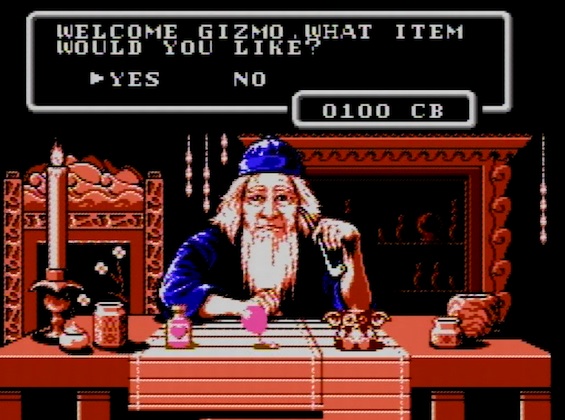
I mean, would a Red Dawn video game feature recurring appearances from that ill-fated history teacher? I’m also surprised that, apart from the aforementioned moment in which the game reconstructs Gizmo’s unfortunate run-in with H2O, there is no incorporation the memorable rules for mogwai ownership. Not that I expected some sort of clock atop the screen counting down to midnight and dictating Gizmo’s next meal, but it would have made sense to include an element wherein he must avoid the intermittent flashes from a spotlight or rising shades revealing sunlight.
The one missing element of the film that keeps the game from attaining greatness is the music. That Gremlins theme is so iconic and inextricably linked to the franchise and I would have loved to hear its 8-bit cover. Its absence from the game often amounts to a hollow experience utterly divorced from the geeky reverence many of us have for the film. Even for those who don’t enjoy the sequel, the music would have at least been a warm, welcome reminder of the first film.
Final Thoughts
After the sound trouncing I suffered at the hands of last week’s Super Star Wars, playing through Gremlins 2 was like a cerebral shiatsu massage. Sure, I again failed to accomplish the ultimate goal of beating the game. But unlike Super Star Wars, it didn’t seem as if the game had a personal agenda against the player. Interesting little tidbit, the Gremlins 2 game that was developed for, among others, the Atari and Commodore 64 was a side-scroller in which the gamer played as Billy and was charged with taking out all manner of evil gremlins with things like flashlights, Frisbees, and those damn tomatoes.
Licensed to Sell
It’s interesting how aggressively the Gremlins franchise was marketed to kids, as so little of the actual film is kid-friendly. I’m not necessarily referring to the violence in the films, which is actually quite cartoony, especially in the sequel; nor is there a prevalence of explicit vulgarity. But the satirical humor, cameos by John Landis, references to Marathon Man, and monster gender confusion represent content and humor that hovers far above the heads of children. But the inherent cuteness of the mogwai and the amazingly cool design of the fully developed gremlins made them instant kiddy commodities and their merchandising potential superseded any gaps in contextual comprehension. Case in point, this collection of snazzy Gremlins 2 trading cards.

Whatever you do, don’t get them wet…because they are made of cardboard.
